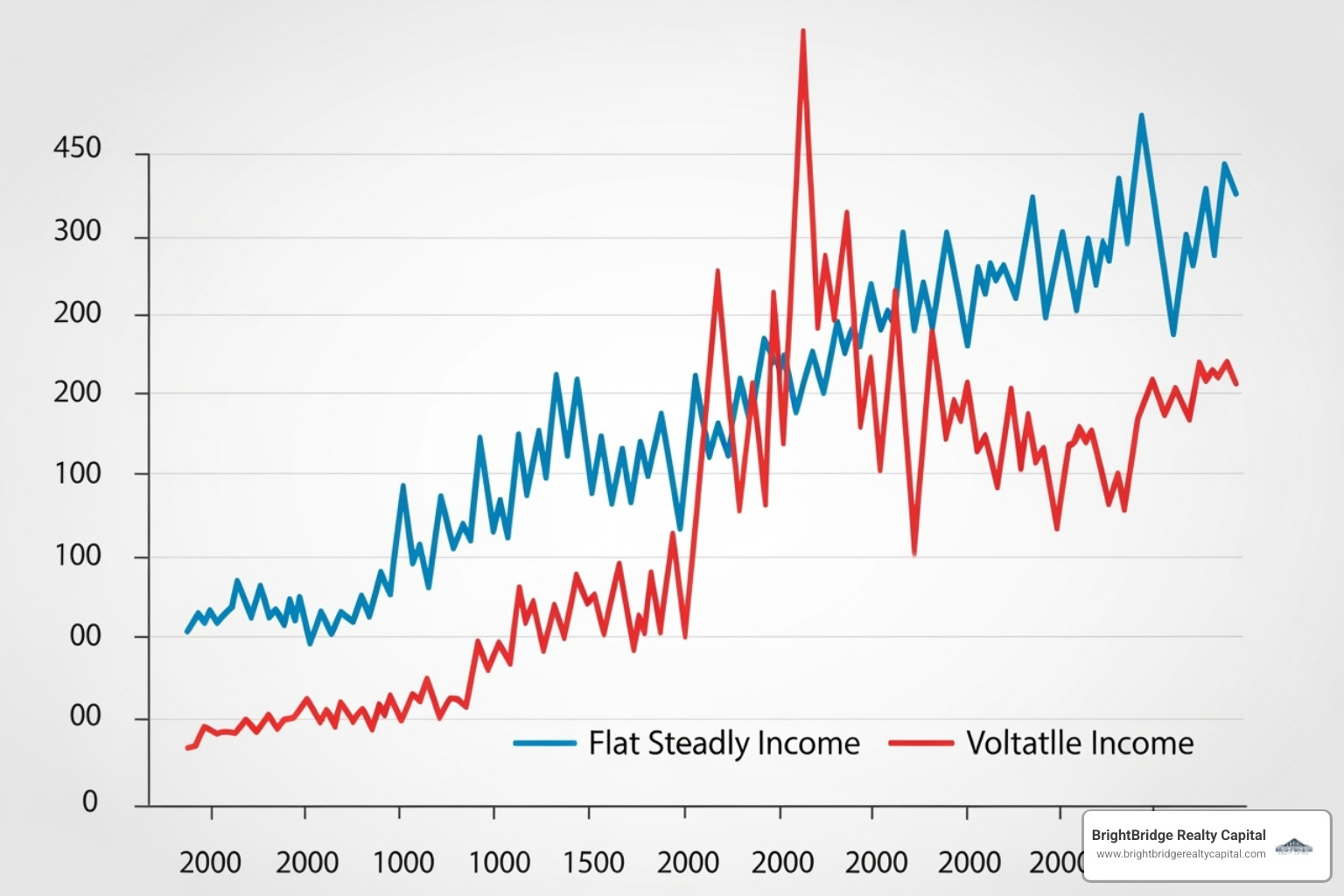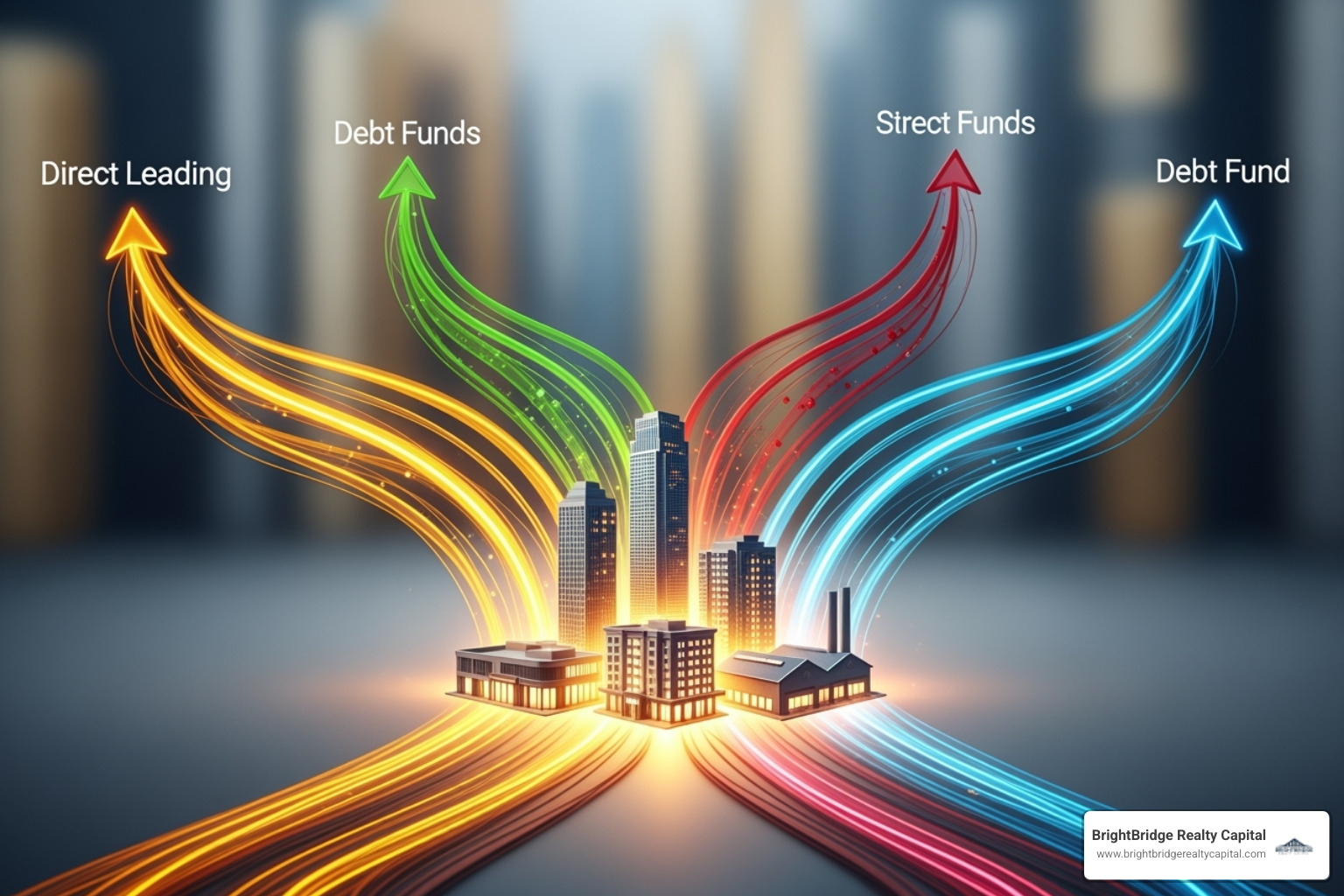Unlocking Real Estate Debt: A Comprehensive Look at Property Financing

Why Real Estate Debt is Revolutionizing Modern Investment Strategies
In an era defined by stock market volatility and persistent inflation, investors are increasingly seeking assets that can fortify their portfolios against uncertainty. Real estate debt is emerging as a cornerstone of modern investment strategies, offering a compelling blend of stability and attractive returns. It is an investment where you act as a lender, not an owner, earning consistent interest on loans secured by tangible property. This asset class offers:
- Predictable Income: Fixed or floating interest payments provide a steady, reliable cash flow stream.
- Lower Risk Profile: As a lender, you hold a senior position in the capital stack with the underlying property as collateral, ensuring you are first in line for repayment.
- Higher Yields: Spreads often range from 500-600 basis points over benchmarks, significantly outperforming traditional bonds (~110 bps).
- Portfolio Diversification: Its low correlation with public stocks and traditional fixed-income markets helps smooth overall portfolio returns.
- Inflation Protection: Floating-rate loans, common in this space, automatically adjust with rising interest rates, protecting your purchasing power.
The real estate debt market reached a staggering $5.0 trillion in the US commercial and multifamily sector as of Q2 2021. With over $2.3 trillion in loans maturing through 2026, a massive wave of refinancing creates expanding opportunities for investors seeking alternatives to direct property ownership.
Debt investments are designed to prioritize capital preservation and steady returns over speculative appreciation, putting investors first for repayment without the operational burdens of property management.
The current market presents unique and timely opportunities. As traditional banks become more conservative due to rising interest rates and tighter regulations, a significant financing gap has opened. Private lenders and debt funds are stepping in to fill this void, a trend that has driven their market share from 10% to 15% in recent years and continues to accelerate.
I'm Daniel Lopez, a loan officer at BrightBridge Realty Capital with extensive experience structuring real estate debt solutions. I've seen how these investments provide the stability and robust returns that savvy investors demand in today's complex market.
What is Real Estate Debt? A Foundational Overview
Investing in real estate debt means you become the bank, lending money to property owners or developers and earning interest in return. The property itself serves as your collateral, giving you the legal right to take ownership to recover your investment if the borrower defaults. This arrangement is formalized through a mortgage or deed of trust, creating a safety net tied to a physical asset.
Compared to traditional fixed income, real estate debt is particularly attractive. While U.S. investment grade corporate bonds might offer spreads around 110 basis points, real estate debt often delivers spreads of 500-600 basis points, which can significantly impact portfolio returns.
The capital stack concept is crucial, as it defines the pecking order for repayment. Senior debt sits at the top, followed by mezzanine debt, preferred equity, and finally common equity. For institutional investors, real estate debt offers a compelling alternative to traditional bonds due to its tangible collateral, higher yield potential, and lower volatility.
The Capital Structure Explained
Understanding seniority in the capital stack is key to assessing risk and reward.
- Senior debt holders have the first lien position. This top spot means the lowest risk, first repayment priority, and more modest returns, making it ideal for capital preservation.
- Mezzanine debt sits in the middle, offering higher potential reward for higher risk. These investors may hold liens on the borrowing entity's equity interests rather than a direct lien on the property.
- Preferred equity is a hybrid, with some debt-like protections. Holders have repayment priority over common equity but are subordinate to all debt holders.
- Common equity investors are the property owners. They have the highest risk but also the greatest potential upside from property appreciation. They are last in line for repayment.
This layered structure provides excellent downside protection for debt investors, as their claim on the property's value is prioritized.
How Real Estate Debt Differs from Traditional Bonds
Tangible collateral is the key difference between real estate debt and traditional corporate bonds. With real estate debt, your investment is secured by a property as security, not just a company's promise to pay.
This direct tie to assets creates several advantages:
- Higher Yield Potential: The spread comparison is striking. Real estate debt typically provides more attractive returns to compensate for illiquidity and the specialized knowledge required.
- Lower Volatility: Property values tend to move more slowly and predictably than stock prices, which translates to steadier returns for debt investors.
- Transparency: You know exactly what asset is backing your investment. You can evaluate the property and its market fundamentals in a way that is impossible with a complex corporate structure.
This combination of security, yield, and transparency makes real estate debt a superior alternative to many traditional fixed-income investments.
The Investor's Edge: Why Add Real Estate Debt to Your Portfolio?

For a portfolio built to weather market storms, real estate debt offers a steadying influence, delivering consistent returns. It provides portfolio diversification and exposure to real estate's stability without the hassles of property management. This is risk mitigation at its finest, combining capital preservation with attractive returns.
One of its key strengths is its natural inflation hedging capability. As prices rise, floating-rate loans adjust upward, increasing your income. At the same time, the underlying real estate collateral typically appreciates, adding another layer of security to your investment.
The Benefits of Investing in Real Estate Debt
Stable income is a primary benefit. As a debt investor, you receive predictable cash flow from regular interest payments, providing consistency in a volatile market.
Another key advantage is its low correlation to stocks. When equity markets are turbulent, real estate debt investments can provide a stabilizing balance to your overall portfolio.
Built-in downside protection comes from the tangible collateral backing each loan. If a borrower defaults, you have a claim on a real property, not just an empty promise.
The historical performance of this asset class speaks for itself. Private real estate debt delivered average total returns of 6.0% per year over the 20 years from 2001 to 2020, with only one year of negative returns during that period. For more on current opportunities, our analysis Is Now a Good Time to Invest in Real Estate Debt? explores today's market dynamics.
Performance Through Economic Cycles
Real estate debt proves its worth by performing well even in difficult economic conditions.
During a recession, it demonstrates remarkable resilience. Amid the COVID-19 disruption, private real estate debt delivered a solid 6.3% total return in 2020, with delinquency rates remaining well below those seen during the Global Financial Crisis. This stability is a result of disciplined underwriting and conservative loan structures.
Inflationary environments can actually benefit real estate debt investors, particularly those with floating-rate loans. As central banks raise interest rates to fight inflation, payments on these loans adjust upward. This interest rate adjustment provides natural market stability. While inflation erodes the value of many fixed-income assets, floating-rate real estate debt adapts, and the underlying collateral tends to appreciate, further securing the investment.
Navigating the Landscape of Real Estate Debt Investments

The real estate debt landscape has transformed, moving from a bank-dominated market to a dynamic space where private lenders and specialized funds create significant opportunities for investors.
The Evolution of the Lending Market
The 2008 Global Financial Crisis fundamentally changed real estate lending. Post-crisis regulations like the Dodd-Frank Act and the Volcker Rule made it more difficult and costly for traditional banks to finance complex or transitional real estate deals.
As banks retreated, private lenders stepped in to fill the financing gap. Private real estate debt funds seized this opportunity, raising $150 billion over the past five years. Consequently, private lenders have grown their market share from 10% historically to 15% by mid-2021. With banks remaining conservative, this trend continues, establishing private real estate debt as a key pillar of property financing.
How to Invest: Real Estate Debt Funds and Direct Lending
Investors can enter the real estate debt market through two main paths: debt funds or direct lending. The best choice depends on your investment goals.
Real estate debt funds pool capital from multiple investors, offering instant diversification and professional management. Funds provide access to institutional-quality deals you might not find alone. However, they come with management fees and profit-sharing, and you give up direct control over lending decisions.
Direct lending, our specialty at BrightBridge Realty Capital, puts you in control. You lend directly to borrowers, controlling underwriting and terms without intermediary fees. This approach requires more time and expertise and carries higher concentration risk, but it offers maximum control and potentially higher net returns.
Key Investment Strategies for the Current Market
Certain real estate debt strategies are particularly compelling in the current market, each catering to different risk appetites and return objectives.
- Senior tranche investing offers the highest level of security with a first-lien position on the property. This means that in a foreclosure scenario, the senior lender is paid back from the sale proceeds before any other stakeholder. This 'top of the stack' priority makes it ideal for conservative investors focused on capital preservation and generating steady, predictable income with minimal risk.
- Mezzanine financing bridges the gap between senior debt and the borrower's equity, offering more attractive yields for those willing to take on slightly more risk. This type of debt is subordinate to the senior loan but senior to all equity positions. It is often secured by a pledge of the ownership interests in the property-owning entity rather than a direct mortgage. The higher risk is compensated with higher returns, sometimes including an equity 'kicker' that allows the lender to participate in the property's upside.
- Bridge loans are flexible, short-term solutions (typically 1-3 years) that help borrowers manage timing gaps. For example, a borrower might use a bridge loan to acquire a property quickly before securing long-term financing, or to fund renovations that will increase the property's value and qualify it for a better permanent loan. Their speed and flexibility are invaluable for opportunistic investors capitalizing on time-sensitive deals.
- Construction loans fund new builds and major renovations from the ground up. These loans are typically disbursed in stages, or 'draws,' as construction milestones are met and verified by inspectors, which helps mitigate risk for the lender. While more complex due to development, entitlement, and completion risks, they offer some of the highest interest rates in the debt space to compensate for these additional factors.
Matching your strategy to market conditions and your risk tolerance is key. For more, see our guide on Real Estate Debt: Top Strategies for 2025.
The Mechanics of a Deal: Risk, Reward, and Market Dynamics
Understanding the mechanics of real estate debt—its market size, risks, and rewards—is key to making smart investment decisions.
Understanding the Market Size and Opportunity
The U.S. commercial and multifamily mortgage debt market is massive, growing 34% over five years to $5.0 trillion as of Q2 2021. This is about half the size of the entire U.S. corporate bond market.
Crucially for investors, over $2.3 trillion in existing commercial and multifamily loans are set to mature between 2022 and 2026. This wave of maturing loans creates a continuous cycle of refinancing and new lending opportunities. Before COVID, annual origination volume was growing at about 9% per year, signaling robust and ongoing demand. Data from sources like the St. Louis Federal Reserve confirm these fundamental market shifts.
Key Risks and Considerations for Real Estate Debt Investments
While real estate debt has significant benefits, investors must also understand its risks.
- Credit risk: The risk that a borrower will default on their payments.
- Market risk: The risk of an economic downturn or drop in property values affecting a borrower's ability to pay.
- Liquidity concerns: Private debt is an illiquid investment; capital is tied up for the loan term.
- Interest rate risk: With fixed-rate loans, you may be locked into a lower rate if market rates rise.
- Capped returns: Your upside is limited to the agreed-upon interest rate, unlike equity investments where appreciation potential is unlimited.
Here's how real estate debt compares to equity investments:
| Feature | Real Estate Debt | Real Estate Equity |
|---|---|---|
| Position in Capital Stack | Senior (first to be paid) | Subordinate (paid last) |
| Risk Profile | Lower | Higher |
| Return Profile | Fixed interest payments, capped upside | Potential for significant appreciation, uncapped upside |
| Income Type | Predictable interest income | Variable, dependent on property performance/appreciation |
| Collateral | Secured by property | Ownership of property |
| Downside Protection | High (due to collateral and seniority) | Low (direct exposure to market fluctuations) |
| Liquidity | Generally illiquid | Generally illiquid |
Essential Underwriting Criteria
At BrightBridge Realty Capital, solid underwriting is paramount. We evaluate every deal using proven criteria to ensure its viability.
- Loan-to-Value (LTV) ratio: We compare the loan amount to the property's value, preferring LTVs below 80% to ensure the borrower has significant equity.
- Debt Service Coverage Ratio (DSCR): We verify that the property's income can comfortably cover loan payments, typically looking for a DSCR of at least 1.25.
- Property valuation: We conduct a deep analysis of comparable sales, market trends, and property condition, carefully vetting After-Repair Value (ARV) estimates for renovation projects.
- Borrower creditworthiness: While collateral provides security, we examine a borrower's financial strength and track record. Reliable borrowers who pay on time are always preferred.
- Market conditions and location: We analyze local economic trends, job growth, and population changes that impact property values and rental demand.
Frequently Asked Questions about Real Estate Debt
What is the difference between investing in real estate debt and equity?
Investing in real estate debt means you act as the bank, lending money for regular interest payments. Your returns are predictable, and you have cash flow priority as a lender. In contrast, equity investing means you are the property owner, with returns dependent on rental income and appreciation. The risk profile is the key difference: debt investors trade unlimited upside for steady income and better downside protection, as they sit at the top of the capital stack. Equity investors take on more risk for a chance at higher rewards but are last in line for repayment.
How do real estate debt funds make money for investors?
Real estate debt funds generate returns for investors primarily through interest payments on the loans they originate, with rates often starting around 9% or higher. They also earn income from borrower fees, such as origination fees (charged upfront) and exit fees (charged on early repayment).
Most funds use a preferred return structure, where investors receive a target return (e.g., 8%) before the fund managers take their share of the profits. Any additional profits are then split via profit sharing arrangements. While investors pay fund management fees, this structure aligns the interests of both the investors and the managers.
Is real estate debt a safe investment during a recession?
While no investment is recession-proof, real estate debt has built-in advantages that make it a relatively safe option, especially compared to equity. The primary advantage is collateral protection—every loan is backed by a physical property. Because of their seniority in default, debt investors are first in line to get paid back if a property is foreclosed.
Past downturns demonstrate this resilience. During the COVID-19 pandemic, real estate debt delivered returns of 6.3% in 2020, with low delinquency rates. This is due to the industry's adoption of more conservative underwriting since 2008. Real estate debt offers lower volatility than equity, providing a cushion against economic shocks, making it an attractive option for investors seeking growth without excessive risk.
Conclusion: Securing Your Financial Future with Real Estate Debt

In summary, real estate debt is more than just another investment; it's a strategic pillar for building resilient, long-term wealth. It offers a rare and powerful combination of stability and diversification, providing predictable income streams backed by the security of physical assets. As an investor, you are contractually positioned first for repayment, effectively shielding your capital from the extreme volatility that often characterizes equity markets. This focus on capital preservation does not mean sacrificing returns; it means achieving them with greater predictability and peace of mind.
The current market opportunity is particularly compelling. With over $2.3 trillion in loans maturing in the coming years and traditional banks pulling back, private lenders are ready to fill a critical and expanding financing gap. This is not a fleeting trend but a structural shift in the lending landscape. Smart investors are positioning themselves to benefit from this dynamic by providing essential capital and securing attractive, risk-adjusted yields in return.
At BrightBridge Realty Capital, we specialize in helping investors tap into these opportunities through our transparent direct lending model. We eliminate unnecessary middlemen to provide competitive rates, personalized service, and quick closings—often within a week. We see ourselves as your dedicated partners in navigating this exciting and rewarding space.
Whether you're a seasoned investor looking to diversify or new to real estate debt, we're here to provide the expertise and support you need. The market is ripe with opportunity, and the time to act is now.
Ready to explore how real estate debt can secure your financial future? Explore flexible financing solutions with BrightBridge Realty Capital today, and let's start building your path to consistent, collateral-backed returns.


